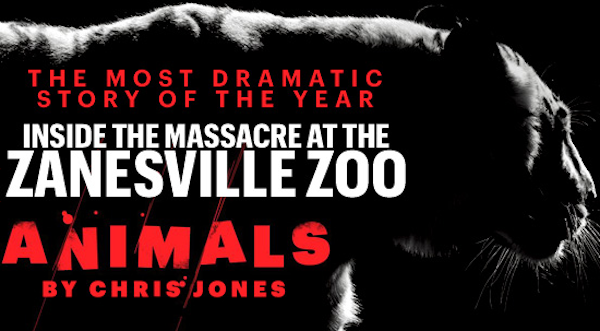

The Internet may have disrupted traditional journalism schedules — no need to wait for the 6 p.m. news or the next morning’s paper — but that doesn’t mean timing doesn’t still matter. How many minutes pass before a reporter gets on the scene of breaking news. How much daylight is left between writing and an impending deadline. And maybe most importantly, when it’s time to publish. Timing can affect how broadly a piece is read, whether it leads coverage in other outlets, and whether it spurs investigation and legislation. The trick of timing is maybe even more crucial in the world of monthly magazines, where the time necessary to produce a story can be out of sync with both the regular news cycle and the day paper hits newsstands.
Yesterday GQ and Esquire published dueling stories online on Terry Thompson and his zoo in Zanesville, Ohio, the one that grabbed the world’s attention last October when the animals were set loose. I’d encourage you to read (or at least Instapaper) them both: Here’s Chris Jones’s “Animals” in Esquire, and Chris Heath’s “The Insane True Story of the Zanesville Zoo Escape” in GQ. These are the stories magazines are made for, probing and colorful, with a subject just familiar — and bizarre — enough that readers don’t have to spend much time recalling the basic facts. Both stories don’t officially hit newsstands until next week. But what makes this case interesting is that Esquire, in trying to get a jump on marketing the piece and put a little multimedia muscle behind it, may have tipped its hand a little early.
Sunday night, Esquire released a short trailer for Jones’ piece on Esquire.com. Less than a minute in length, the trailer combines audio from interviews and 911 calls with images from Thompson’s compound. It was a novel new approach to getting readers attention to a magazine story; it also didn’t hurt that the trailer was the perfect bite size portion for flittering around Twitter, Facebook and Tumblr. Speaking to Brian Stelter, deputy editor Peter Griffin said when editor-in-chief David Granger “remarked that the article ‘read like a movie,’ I said we should promote it like the action movie of the winter, so let’s do a trailer.”
A smart, fun, idea, but one that perhaps ended up costing Esquire a hint of exclusivity as Heath’s GQ’s story saw the light of day a few hours later. In response, Esquire posted its piece online, a decision that did not escape Jones’ notice:
Thanks to GQ posting their own Zanesville story, mine is now up: tinyurl.com/79mbd95
— Chris Jones (@MySecondEmpire) February 6, 2012
Jones also tweeted that he and Heath stayed in the same hotel in Zanesville while covering the story, which means both had an idea the other was on the trail, but may have been uncertain when their stories would come out of the oven ready for readers.
@tommytomlinson: I found that fear of being embarrassed by a rival national magazine was an excellent motivator.
— Chris Jones (@MySecondEmpire) February 7, 2012
Condé Nast spokesperson Corey Wilson told me over email GQ doesn’t typically publish stories ahead of the magazine online unless there are special circumstances. (Like, say, an interview with Katherine McPhee posted ahead of her show “Smash” debuting on NBC.)
The Internet, and by extension social media, have done a lot for making news organizations more transparent — sometimes willingly, sometimes not — about how they produce their journalism. But at a certain level, magazines are still behind a veil. Maybe it’s the culture that surrounds the world of magazines, or perhaps that, aside from the newsweeklies, many magazines rely on a mix of news and features each issue that isn’t easy to predict.
But like everyone else in the journalism world magazines have also been dragged into the new realities of online media, where websites need elements of timeliness, relevance, and stickiness, to be successful. Even as magazines face declines in print circulation and challenges for visibility online, it’s never been easier to promote their work and try to build anticipation around stories. Of course, readers today sometimes have little tolerance for anticipation, as we saw last year when Rolling Stone tried to tease its profile of Stanley McChrystal. The Internet wasn’t having it, and in the time it took for the piece to get on RollingStone.com, the magazine paid a price.
(For what it’s worth, as of this morning, Esquire’s winning the Facebook battle — 420 “likes” for its story vs. 296 for GQ’s — but GQ’s winning the Twitter battle 161-89.)